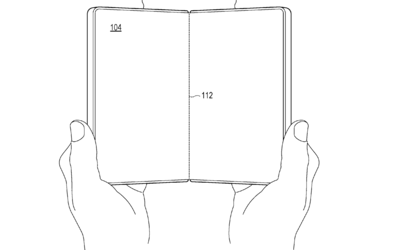Microsoft is reportedly exploring a new direction in the foldable device market, potentially challenging the dominance of iPhone and Android smartphones. Despite the discontinuation of the Surface Duo series, the tech giant's ambition in the foldable space remains evident through a recently uncovered patent.

A patent application, filed with the United States Patent and Trademark Office on February 29, showcases Microsoft's approach to foldable devices, focusing on a single-hinge technology dubbed the "spine cover plate."
The patent suggests a design akin to the Galaxy Z Fold, featuring a flexible display in a book-style format. The core innovation lies in the spine cover plate, intended to shield the device's single-hinge system. This mechanism aims to protect the hinge from external elements by automatically adjusting during opening and closing, preventing gaps that could expose the device to dust and water. Samsung's current foldable design, while water-resistant with an IPX8 rating, doesn't offer complete protection against dust intrusion.
Microsoft's design also aims to minimize the visibility of the hinge crease, a common concern among foldable smartphone users. The new hinge mechanism purportedly allows for a less noticeable crease compared to existing solutions.
Furthermore, the patent outlines methods to reduce the overall thickness of the foldable smartphone. By enabling the spine cover plate to move closer to the device's hinge when folded, Microsoft aims for a more ergonomic design.
“By retracting the spine cover plate toward the central spine as the first display-supporting frame and the second display-supporting frame are rotated into a face-to-face orientation, the width of the folded computing device is reduced, thereby enabling easier and more comfortable handling of the device, such as with one hand,” Microsoft stated in the patent.
While the concept is intriguing, the practicality of adding another movable part to the already complex foldable mechanism remains uncertain. The market is constantly seeking ways to eliminate the crease and enhance the durability of foldable devices. Despite the potential benefits and enhanced durability touted in the patent application, the addition of a movable spine cover plate may raise concerns about the device's overall robustness.
Newer articles
Older articles
 Team India Settles in Birmingham: Rahul's Mattress, Coaches' Strolls, and the Enduring Coffee Ritual
Team India Settles in Birmingham: Rahul's Mattress, Coaches' Strolls, and the Enduring Coffee Ritual
 Android Users Urged to Patch Devices Immediately Following Critical Security Flaws Alert
Android Users Urged to Patch Devices Immediately Following Critical Security Flaws Alert
 Ashada Gupt Navratri 2025: Dates, Auspicious Timings, and Esoteric Significance Explained
Ashada Gupt Navratri 2025: Dates, Auspicious Timings, and Esoteric Significance Explained
 JPG to PDF: A Graphic Designer's Guide to Conversion & Best Practices
JPG to PDF: A Graphic Designer's Guide to Conversion & Best Practices
 Skin Cancer Alert: How to Identify Suspicious Moles and Early Warning Signs
Skin Cancer Alert: How to Identify Suspicious Moles and Early Warning Signs
 IRCTC's AskDisha 2.0: AI Chatbot Streamlines Train Ticket Booking, Refunds, and Travel Information
IRCTC's AskDisha 2.0: AI Chatbot Streamlines Train Ticket Booking, Refunds, and Travel Information
 The stat that could swing every NBA team's 2025-26 season
The stat that could swing every NBA team's 2025-26 season
 Bollywood's Mythological Muse: How Indian Epics Inspire Cinematic Storytelling
Bollywood's Mythological Muse: How Indian Epics Inspire Cinematic Storytelling
 Bollywood Flashback: Jackie Shroff Accused of Untoward Advance on Young Tabu at Danny Denzongpa's Party
Bollywood Flashback: Jackie Shroff Accused of Untoward Advance on Young Tabu at Danny Denzongpa's Party
 Popular Finance YouTuber's Account Hacked: Bitcoin Scam Alert and Security Tips
Popular Finance YouTuber's Account Hacked: Bitcoin Scam Alert and Security Tips